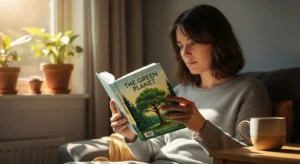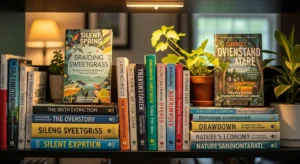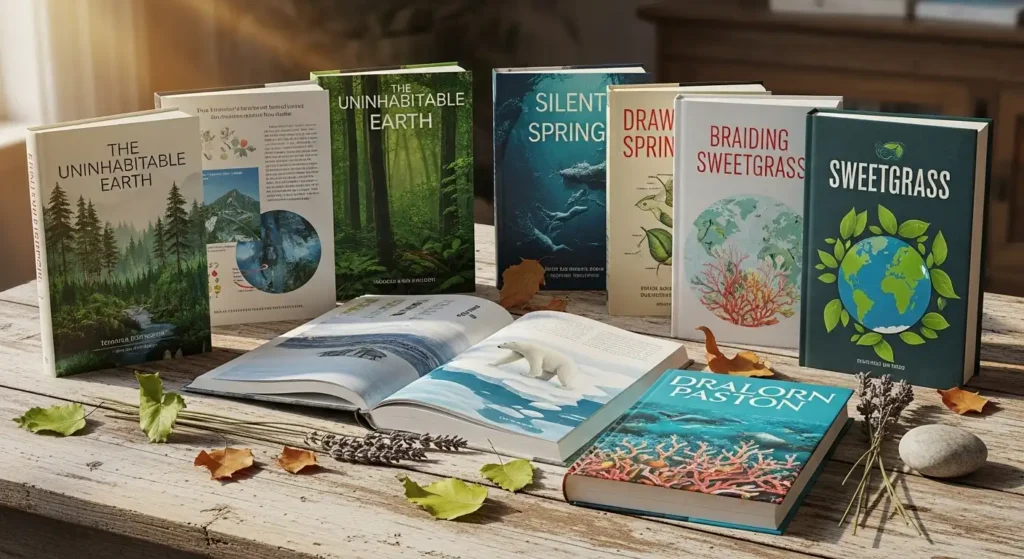In a world where environmental challenges dominate headlines, literature has stepped up to reflect and reimagine our relationship with the planet. Books with environmental themes are no longer niche—they are central to today’s literary landscape. These works help readers process eco-anxiety, imagine solutions, and explore humanity’s interconnectedness with nature. Whether you enjoy speculative fiction, memoir, or non-fiction, there are countless titles that address climate, ecology, and sustainability in compelling ways.
Why Environmental Themes in Literature Matter
 Environmental storytelling plays a vital role in shaping how society views ecological issues. While scientific reports provide data, fiction and narrative non-fiction give us human perspectives and emotional engagement. They remind us that behind every statistic lies lived experience—communities adapting to climate change, ecosystems under threat, and individuals finding ways to heal the earth.
Environmental storytelling plays a vital role in shaping how society views ecological issues. While scientific reports provide data, fiction and narrative non-fiction give us human perspectives and emotional engagement. They remind us that behind every statistic lies lived experience—communities adapting to climate change, ecosystems under threat, and individuals finding ways to heal the earth.
Books featuring environmental themes also inspire action. They spark discussions, influence policies, and motivate readers to reflect on their daily choices. In 2025, these works are more relevant than ever.
Classic Foundations: Environmental Literature Before 2000
Modern environmental writing owes much to earlier trailblazers. These classics continue to resonate:
- Silent Spring by Rachel Carson – Often credited with igniting the environmental movement, this book exposed the dangers of pesticides like DDT and reshaped policy worldwide.
- Walden by Henry David Thoreau – A foundational work exploring simple living, solitude, and our philosophical connection with nature.
- The Monkey Wrench Gang by Edward Abbey – A rebellious novel that inspired generations of environmental activists.
Modern Cli-Fi: Climate Fiction for Today
Speculative fiction has embraced climate change as a central theme. These “cli-fi” novels capture the urgency and creativity of imagining possible futures:
- The Overstory by Richard Powers – A Pulitzer Prize-winning novel that weaves together stories of people and trees, highlighting the resilience and importance of forests.
- Parable of the Sower by Octavia E. Butler – Though published in the 1990s, its depiction of climate collapse and societal upheaval feels prescient and urgent today.
- Ministry for the Future by Kim Stanley Robinson – A sweeping vision of climate politics, activism, and survival strategies that bridges science and storytelling.
Memoirs & Non-Fiction Narratives
Not all environmental books are speculative—memoirs and essays bring the subject closer to home:
- Braiding Sweetgrass by Robin Wall Kimmerer – Blends Indigenous wisdom, botany, and personal reflection to create a deeply moving exploration of reciprocity with the natural world.
- The Uninhabitable Earth by David Wallace-Wells – A sobering yet essential read about the possible futures humanity faces if climate change is unchecked.
- Farming While Black by Leah Penniman – Explores sustainable agriculture, food justice, and reclaiming ancestral practices.
Children’s & Young Adult Environmental Reads
Younger readers are also discovering books with environmental themes that spark curiosity and awareness:
- The Lorax by Dr. Seuss – A timeless classic reminding children about the importance of protecting natural resources.
- Dry by Neal Shusterman and Jarrod Shusterman – A YA novel depicting a California drought so severe that communities are pushed to their limits.
- Flush by Carl Hiaasen – A middle-grade eco-mystery tackling pollution and conservation with humor and adventure.
Why Readers Are Drawn to Environmental Books
 There are many reasons readers gravitate toward eco-themed literature:
There are many reasons readers gravitate toward eco-themed literature:
- Eco-Anxiety Relief: Stories help process fear about the environment by showing resilience and solutions.
- Educational Value: Readers gain insights into ecosystems, sustainability practices, and climate science.
- Inspiration for Action: Many books highlight individuals making a difference, encouraging readers to do the same.
Tips for Exploring Environmental Literature
- Mix Genres: Balance heavy non-fiction with uplifting fiction or children’s books to avoid burnout.
- Support Diverse Voices: Seek authors from communities most affected by environmental issues.
- Join Book Clubs: Environmental book clubs are growing in popularity, offering spaces to discuss stories and solutions.
- Start Local: Explore books about your own region’s ecology to build personal connection and relevance.
The Future of Environmental Literature
In 2025, books with environmental themes are expanding across every shelf—from thrillers to romance. Publishers are investing in stories that integrate sustainability and climate into everyday narratives, not just speculative fiction. As climate change continues to shape society, literature will remain a vital way to imagine futures, heal communities, and inspire readers.
Conclusion
Environmental literature is more than a trend—it’s a mirror of our times and a compass for the future. Whether you’re drawn to classics like Silent Spring, speculative visions like Ministry for the Future, or lyrical reflections like Braiding Sweetgrass, books with environmental themes offer wisdom, warning, and hope. For eco-conscious readers in 2025, they are essential companions on the journey toward a sustainable world.
If you enjoyed this post, explore our related articles on Why Climate Fiction & Hopepunk Are the Uplifting Stories We Need Right Now and Speculative Fiction You Must Read in 2025.
